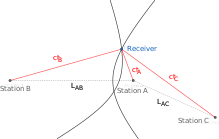
Hyperbolic navigation is a class of radio navigation systems in which a navigation receiver instrument is used to determine location based on the difference in timing of radio waves received from radio navigation beacon transmitters.
Such systems rely on the ability of two widely separated stations to broadcast a signal that is highly correlated in time. Typical systems broadcast either short pulses at the same time, or continual signals that are identical in phase. A receiver located at the midpoint between the two stations will receive the signals at the same time or have identical phase, but at any other location the signal from the closer station will be received first or have a different phase.
Determining the location of a receiver requires that the two synchronized stations be tuned in at the same time so the signals can be compared. This reveals a difference in time, corresponding to a relative distance closer to one station or the other. Plotting all the locations where this time difference may occur produces a hyperbolic line on a chart. To take a "fix", a second station pair is also turned in to produce a second such curve. The two curves will normally intersect at two locations, so some other navigation system or a third measurement is needed to determine the exact location.
Hyperbolic location systems were first used during World War I in acoustic location systems for locating enemy artillery. The sound of a shell being fired was received by several microphones, and the time of reception sent to a computing center to plot the location. These systems were used into World War II. The first hyperbolic radio navigation system was the World War II-era Gee, introduced by the Royal Air Force for use by RAF Bomber Command. This was followed by the Decca Navigator System in 1944 by the Royal Navy, along with LORAN by the US Navy for long-range navigation at sea. Post war examples including the well-known US Coast Guard Loran-C, the international Omega system, and the Soviet Alpha and CHAYKA. All of these systems saw use until their wholesale replacement by satellite navigation systems like the Global Positioning System (GPS) in the 1990s.
In 2023 a prototype navigation system was tested based on detection of muon subatomic particles coming with cosmic rays, which would work underground and underwater.[1][2]
- ^ Tokyo, University of. "Underground navigation may be possible with cosmic-ray muons, research shows". techxplore.com. Archived from the original on 2023-06-15. Retrieved 2023-06-20.
- ^ Tanaka, Hiroyuki K.M.; Gallo, Giuseppe; Jon, Gluyas; Kamoshida, Osamu; Lo Presti, Domenico; Shimizu, Takashi; Steigerwald, Sara; Takano, Koji; Yang, Yucheng; Yokota, Yusuke; muPS Collaboration (2023-07-21). "First navigation with wireless muometric navigation system (MuWNS) in indoor and underground environment". CellPress. 26 (7). Bibcode:2023iSci...26j7000T. doi:10.1016/j.isci.2023.107000. PMC 10391674. PMID 37534132.


